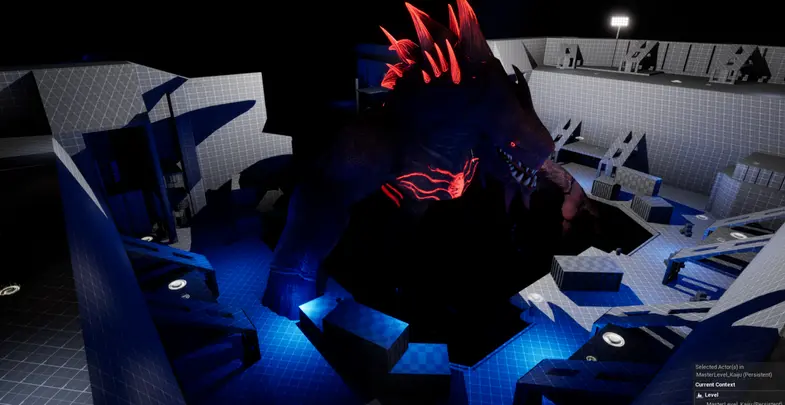KaiJu
Coopertaion Project
Project Type: Multiplayer VR Game
Genre: Horror, Action
Period: 2023 Fall- 2025 Spring(5 Semaster)
Software: UnrealEngine5.2, KatVR Treadmill, bHaptics Tactsuit, Meta Quest, Hand-tracking.
Hardware: Traidmil, Haptic Tactsuit, Quest2/3
Project Position:
Primary Role: Level Designer
-
Design Level: tutorial. old greenroom level, boss room level
-
Boss Fight behavior design
-
Haptic Tracksuit creation and implementation
-
molding implement and detail decoration
-
Documentation
-
Help Angle Liu communicate with Autio/art team.
Project Discription
Kaiju Project is a heart-pounding survival horror VR game where players, cast as lowly interns in a remote, secretive research facility, must navigate a crumbling labyrinth of laboratories and corridors after a catastrophic experiment releases the very Kaiju it sought to contain. As monsters roam freely, players must use remnants of failed experiments, forge alliances with other survivors, and uncover dark secrets hidden within the facility. With intense haptic feedback, immersive treadmill navigation, and a gripping narrative, Operation Colossus challenges players to survive, escape, and uncover the terrifying truths behind the facility’s deadly legacy.
What I am doing for this project
In the first semester, our group discussed various research directions and ultimately decided to explore how to use Quest and Treadmill technology within Unreal Engine 5. We also discussed the overall game concept and decided on a multiplayer cooperative action-thriller game.
During the first semester, I focused mainly on studying how to connect Quest 2 with Unreal Engine 4.27 and worked with Angela Liu to define the game's storyline and design the first phase of cooperative levels.In order to provide players with a more immersive experience, we have decided to use hardware devices such as hand tracking, treadmills, and haptic feedback.
The game's story is as follows:
You will play as a character named "CoffeeBoy." In order to acquire a massive fortune, you decide to infiltrate the Kaiju Research Institute on a remote island to steal their latest research—the energy injection serum. This is the perfect opportunity for you, as the institute is holding a demonstration of their newest findings. However, during the presentation, an unfortunate event occurs—the containment box holding the Kaiju creatures wasn’t properly sealed, and the Kaiju awakens. Faced with this sudden crisis, you have no choice but to escape, with your survival uncertain…
In the second semester, our project began to take shape. During this time, Unreal Engine released a new version. After several discussions, we decided to move our project to Unreal Engine 5. This semester, I designed Level 2 - the rooftop level. It is a Greenroom filled with various research inventions combining Kaiju and plant life. You will be searching for an escape route here. This level is one of the most exciting parts of our game. Through VR, you will experience the destruction of the building as it collapses.
At first, I was constrained by the camera logic in Sequencer. The camera view didn’t align with the player’s perspective via Quest. There was a conflict between the camera and the game’s camera system, which meant it couldn’t present a fixed player viewpoint like a traditional 3D game. However, the camera’s movement path could still be executed on the player. Fortunately, camera shaking can also be applied to VR headsets.The issue was that if the player looked around freely, the game camera couldn’t control or restrict the player’s viewpoint.
Since the camera was unusable, I focused on the gravity placement system. As long as the player could walk on slopes, the natural falling effect would be achievable. To create this effect, I designed air walls that allowed the player to slide naturally to the correct position in the game world. The video beside shows the initial camera setup I used.
The third semester was a short summer semester during which I wasn’t present. However, the new team members made significant changes to the walkthroughs, tightening the game’s logic and making it more cohesive. They moved the Greenroom from the rooftop level to a lower section, and now players could see the Kaiju attacking the building.
In the fourth semester, I began designing the boss room and boss fight, as well as integrating BHaptic vibrations. Thanks to the changes made in the third semester, our story structure evolved. You are now a spy sent to investigate the Kaiju outbreak, with the goal of eliminating all the Kaiju on the island.
However, during the design process, we realized that with the game set during the daytime, players could see everything clearly, which didn’t help create the right atmosphere. As a result, we decided to switch to a night mode and added horror elements to enhance the experience. Since our level design was more advanced than our technical design, and we didn’t have an animator, I took the initiative to design the boss fight mechanics. I spent most of the remaining time researching how to implement BHaptic vibrations and integrating BHaptic with Unreal Engine 5.
bHaptics Haptic Vest Experience Design
The bHaptics vest consists of 20 small vibration motors that simulate various tactile sensations, such as gunshot impacts, monster attacks, or environmental damage. While bHaptics supports full-body sensors, our project focuses solely on the vest to enhance player immersion.
Fortunately, each vibration module can be individually adjusted in intensity, making the haptic experience more dynamic and realistic. The biggest challenge in the design process was imagining how different types of damage would feel to the human body. To gain inspiration, I studied numerous stunt performances on YouTube and deeply contemplated how they physically react to “pain” in real-world scenarios.
This is my fifth and final semester working on this game. Currently, we are preparing for GDC by refining the details of the levels. I have created the lighthouse and the monster beneath it, enhanced the details of the Greenroom and its connecting corridors, and implemented dynamic night-time weather changes. Additionally, I have developed breakable TVs with distance-based sound attenuation, designed the game's main menu and the starting portal.








